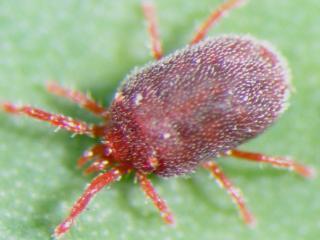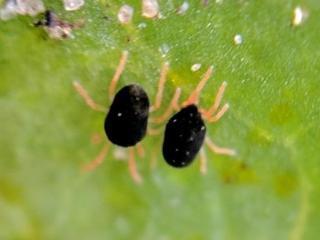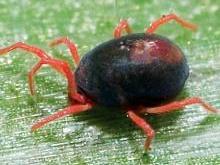Bryobia mites are active. Can you identify the different mite species?
- Aldersyde
- Kulin
- Wickepin
Technical officer Amber Balfour-Cunningham (DPIRD) has reported finding bryobia mites on roadside volunteer canola, wild radish and wild turnip near Aldersyde and Wickepin when conducting surveillance.
Justine Tyson (ConsultAg) reports finding bryobia mites on cotyledon Bonita canola near Kulin. There was no visible damage.
There are two species of bryobine mites that cause damage to WA broad acre crops; Brown wheat mite and bryobia mite (also known as clover mite).
Brown wheat mite is found in cereals only whilst Bryobia mite is found causing damage to canola and lupins. For more information refer to DPIRD’s Diagnosing brown wheat mite page.
These mites are most damaging to germinating crops when they transfer from dying weeds, due to a knock-down spray, onto germinating crops.
These mites are most damaging when crops are moisture stressed and temperatures are above 20oC. Growers are recommended to consider control only if crops are unable to out-grow feeding damage.
Correct identification of mites is critical for effective control, as different species can vary in their susceptibility to certain insecticide groups, either naturally or through insecticide resistance. Chemicals applied for control of the wrong pest may result in expensive loss of plant seedling density or having to re-sow some paddocks.
As weather conditions continue, it is expected that Balaustium mite will be also present in paddocks and cooler weather will lead to hatchings of earth mites (blue oat mite and redlegged earth mite).
Identifying different mites in crops
Adult bryobia mites are reddish-grey with a pie-shaped body, red legs and two long forelegs. For more information refer to DPIRD’s Diagnosing bryobia mite page.
The adult balaustium mite has a brownish / red body and red legs. If viewed under a magnifying glass or microscope it has short, stout, velvety hairs can be seen covering the body. The adult balaustium mite grows to almost twice the size of redlegged earth mites. Several generations can occur each year. For more information refer to the DPIRD Diagnosing balaustium mite page.
Redlegged earth mite (RLEM) adults are 1mm long with a black body and eight red-orange legs. RLEM have a cold temperature requirement (generally seven days below 20°C average daytime temperatures) before the eggs are triggered to hatch. Immature nymphal RLEM are often a more reddish colour than when they are mature. RLEMs do co-exist with blue oat mites so be careful not to incorrectly diagnose the two mites. For more information refer to the DPIRD Diagnosing redlegged earth mite page.
Blue oat mites look similar to RLEM (i.e. adults are 1mm long with eight red-orange legs and have a dark purplish-blue body) but they have a pale to red dot on their back. For more information refer to DPIRD’s Diagnosing blue oat mites page.
Bryobia mites and balaustium mites are more likely to be seen feeding on plants during warm and sunny parts of the day whilst RLEM and blue oat mites will be more noticeable feeding on leaves on overcast cool days or early morning / late afternoon.
You can confirm the identity of mites by using the DPIRD MyPestGuide Crops app which includes images and information of mite pests. Alternatively, you can send images for confirmation through the PestFax Reporter app.
Managing mites
Before spraying mites it is important to know that economic damage generally only occurs if mites are present in very high numbers or if the crop is moisture stressed. In many years, and under good growing conditions, mites emerge from eggs during or after crop germination and the plants outgrow mite feeding damage. For more information refer to DPIRD’s Earth mites - economic considerations for management page.
For registered insecticide recommendations for mites refer to DPIRD’s 2021 Autumn/Winter Insecticide Guide.
Growers and consultants are urged to apply integrated pest management (IPM) strategies when managing RLEM due to cases of insecticide resistance in WA. These strategies include; identifying mites, rotating different chemical groups and reserving co-formulations or chemical mixtures only for situations where damaging levels of RLEM and other insect pests are present.
For more IPM information see DPIRD’s Prevent redlegged earth mite resistance page and GRDC’s Resistance management strategy for the redlegged earth mite in Australian grains and pastures fact sheet.
For more information on mites contact research scientist Svetlana Micic, Albany on +61 (0)8 9892 8591.
Article author(s): Cindy Webster (DPIRD Narrogin) and Svetlana Micic (DPIRD Albany).





